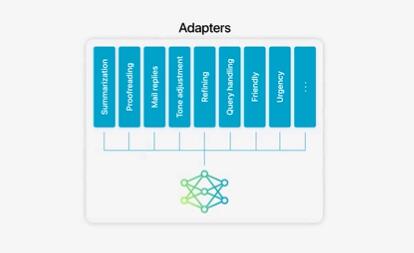Apple recently announced the core technical details of its artificial intelligence platform Apple Intelligence, a powerful system composed of a device-side model with approximately 3 billion parameters and a server-based language model. After evaluation, Apple Intelligence surpassed multiple open source and commercial models in various indicators, and was also more popular in human evaluations. With a wide range of applications, from text creation to notification summaries, it is designed to enhance users' daily experience and is committed to following strict responsible AI principles during development.
News from ChinaZ.com on June 12: Apple recently announced the core technology behind its artificial intelligence platform Apple Intelligence—a device-side model with approximately 3 billion parameters and a server-based language model. In a series of evaluations, Apple Intelligence outperformed open source models including Phi-3, Gemma, Mistral, and DBRX, as well as commercial models such as GPT-3.5-Turbo and GPT-4-Turbo, and was evaluated by humans in most cases. Priority will be given to those who choose.

Optimization and application of Apple Intelligence
Apple Intelligence's underlying models are optimized for writing and polishing text, prioritizing and summarizing notifications, creating interesting images for conversations with family and friends, and simplifying in-app interactions. The model is trained using the open source AXLearn framework, which combines advanced technologies such as data parallelism, tensor parallelism, sequence parallelism, and fully sharded data parallelism (FSDP) to achieve an efficient and scalable training process. Data sources include authorized data and public data crawled by Apple Bot, and all data are strictly filtered to protect user privacy.
Apple Intelligence includes powerful generative models designed for users' daily tasks and adapt on the fly based on current activity. The base model is fine-tuned to enhance the user experience, including composing and optimizing text, prioritizing and summarizing notifications, creating interesting graphics for conversations, and simplifying interactions across apps.
Apple also announced a set of responsible AI principles to guide the development of AI tools and their underlying models. These principles include:
Provide users with smart tools: Identify areas where AI can be used responsibly, create tools that meet specific user needs, and respect the way users use these tools.
Represent our users: Build deeply personalized products that truly represent users around the world and avoid perpetuating stereotypes and systemic bias in AI tools and models.
Careful design: Take precautions at every stage of design, model training, feature development, and quality assessment to avoid AI tools from being abused or causing potential harm, and continuously improve through user feedback.
Protect privacy: Protect user privacy through infrastructure such as powerful local processing and private cloud computing, and do not use users’ private data or user interaction data when training the basic model.
These principles are woven throughout the architecture of Apple Intelligence, ensuring that features and tools are connected to purpose-built models and providing each feature with the information it needs to operate responsibly.
The launch of Apple Intelligence demonstrates Apple's technical strength in the field of artificial intelligence and its emphasis on user privacy. Its responsible AI principles have also set a good example for industry development. In the future, the application and development of Apple Intelligence are worth looking forward to.